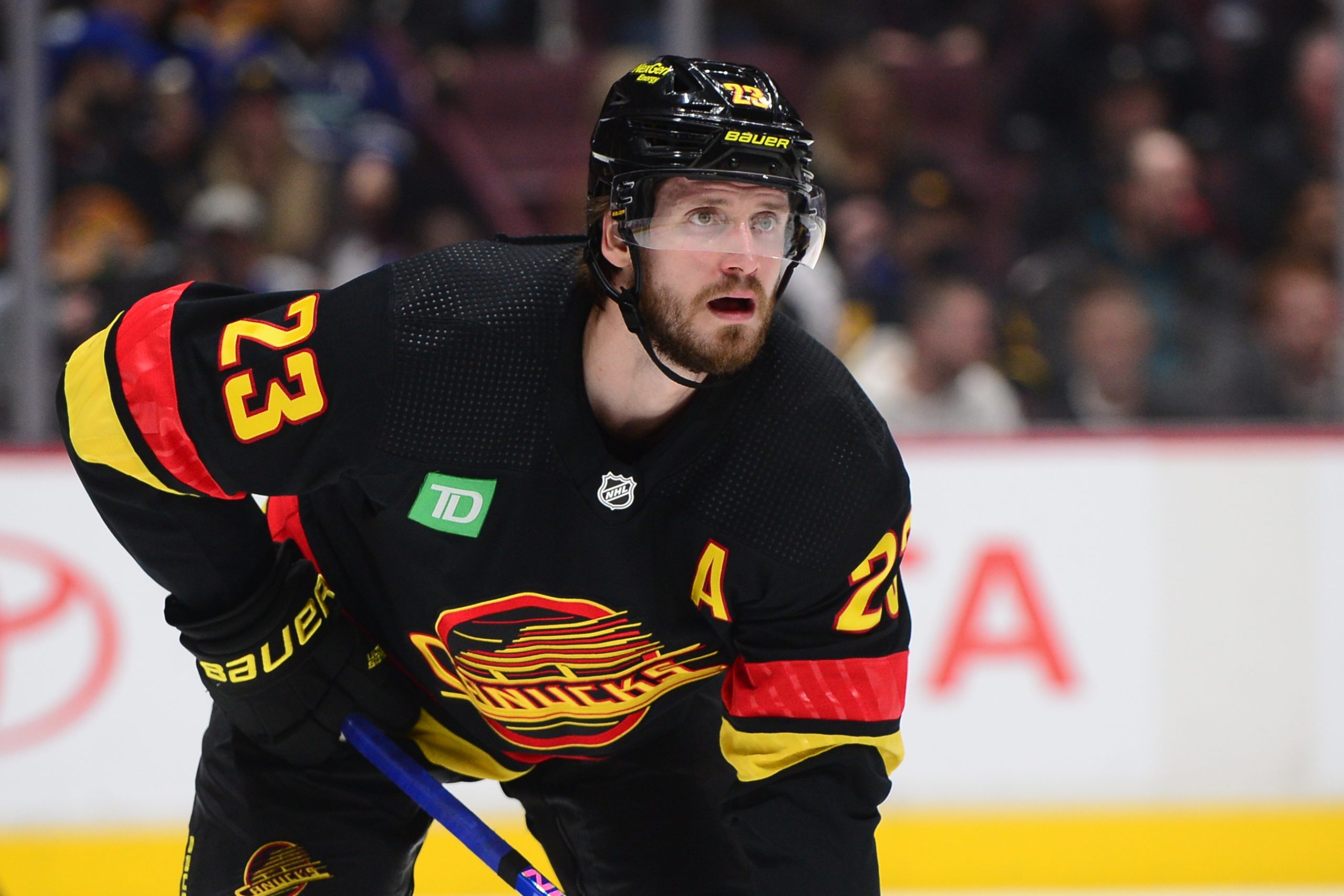When Jim Rutherford raised the option of a Vancouver Canucks buyout, the first thought was “who?” The second was “Wait, how?” All things are possible – if you’re willing to take some heat over them.
Vancouver Canucks Buyout Options Few, But Possible
The possibility of a buyout was raised during general manager Jim Ruthroford’s press conference in January. That’s not exactly news, but the fact that it was raised by Jim Rutherford is. He has, at the very least, entertained the idea.
That’s actually a promising sign. With bonus-laden and restricted-movement clause-filled contracts the usual answer is short: no buyouts. They simply don’t make financial sense, even if the team can’t find a taker in a sweetheart deal.
For instance, the Tyler Myers deal has a $6 million cap hit but only $1 million in actual salary. If it was to get bought out, the $5 million bonus is still on the books as part of the team cap hit for 2023-24. Two-thirds of his salary would be affected, making his total cap hit $5,333,333 in 2023-24 and $333,334 in 2024-25.*
That’s not much of a benefit, especially since the team needs to pay for Myers’ replacement. But the team has said they are serious about getting out of Cap Hell, so buyouts remain a possible – if limited – tool.
Paid To Leave
Look, Vancouver is currently paying two head coaches not to coach the team. Those don’t count against the salary cap, but it’s not like ownership is happy with the situation. At least paying players to go away means the general manager will gain cap space.
It still needs to fit whatever plan is in place, though. As mentioned, removing a player is only half the battle – someone is taking their place. Not only should they be cheaper, but they also need to be capable as well.
We’re going to take a look at four of the Canucks buyout options and how likely they are to happen.
Tanner Pearson
This has not been a great year for Tanner Pearson. Not only has his injury knocked him out for the rest of the season, but the bit he played also wasn’t exactly highlight material. It wasn’t for anyone, but his one goal and five points in 14 games as a bottom-six winger was lousy, especially at his $3,25 million paycheque.
Just so we’re clear on this, his injury should be entirely cleared up by next season. There is no express rule in the CBA saying an injured player can’t get bought out but it seems to be avoided. In any case, Pearson is a useful, if not currently productive, player.
Pearson starts the final year of his deal in 2023-24, and worse has a $1.5 million signing bonus coming. Still, dropping his hit for next year from $3.25 million to $1.4 million might be worth it. It means adding nearly a million dollars to the 2024-25 cap, but his absence is ably filled by Vasily Podkolzin.
Odds: Unlikely, but possible.
Conor Garland
Why Conor Garland‘s name comes up is a bit of a mystery. Outside of “too many wingers” there isn’t really a reason to consider a buyout for him. He is worth his contract – barely – but more importantly Garland can actually drive play.
Garland has three years remaining after the current season and a cap hit of $4.95 million. No bonuses to clutter up the numbers, so they are actually pretty straightforward. Buying out Garland puts his cap hit at a mere $840K for two seasons, then just under $1.9 million for another four.
The addition at the end – the three years after his current contract expires – makes this a useless deal. A player would need to be found to do his job, and if the Canucks really want to let him go, he’ll have some trade value. Retain a quarter of his contract and it all comes off the books three years sooner.
Odds: No. Why would they? Tanking or not, buying out Garland is handing another team free skill. Don’t do that.
Tucker Poolman
Injured players can be bought out if they agree to it, but whether that’s official or more of a “handshake” deal is unclear. In any case, if Tucker Poolman is okay with being one of the Canucks buyout options, they should look at it.
There are complications, of course. For instance, why would Poolman take $2 million less to be injured for the same amount of time? On the other side, if he does recover fully, the right-handed defenceman would be welcomed back.
He has two seasons left at a cap hit of $2.5 million. A buyout would drop that to $500K for those years then $1 million for the two years beyond that. That would actually be of some use to the Canucks, as the empty spot they’d need to fill is in the third pair. Those should come fairly cheap.
Vancouver also wants to get out of the long-term injured reserve pool if at all possible. They’d likely go for this deal, but nothing in life is simple.
Odds: Almost certainly not. Between the Players’ Union likely discouraging the precedent and the commissioner not wanting a can of worms opened, it’s not happening even if Poolman is amenable. If there’s one team that needs less drama in their life, it’s the Canucks.
Anthony Beauvillier
Oh, brutal! Tossing out the new arrival already?
Yes, Anthony Beauvillier has been mentioned as a buyout target, as his current cap hit would drop dramatically. There would be savings of $2.77 million for 2023-24, and that’s something. It would also add $1.4 million for 2024-25, and that is also something, though.
But “Tito” isn’t just a shell. He brings a bit of fire and a bunch of speed with him from the New York Islanders, and Vancouver is in short supply. Being in the last year of his admittedly expensive deal makes him a trade chip next year at least.
Odds: Unlikely. If the Canucks don’t want to keep him, trading him seems a far better option. At the very least, he should get a chance to show what he can do first.
Oliver Ekman-Larsson
This is a lot sooner than originally planned – or hoped – but Oliver Ekman-Larsson‘s play is making it viable. That and his $5.25 million bonus paid out at the beginning of the 2022-23 season being his last. Painful, but an option.
The problem isn’t that Ekman-Larsson isn’t an NHL player – he is. But what he isn’t is a $7.26 million player who should be playing over 20 minutes a night. And if he stays in Vancouver, he’ll be that for another four seasons.
Again, this is the Canucks buyout option they’ll be hearing about for years – eight of them, at least. But exercising that option now – well, in July – lessens the pain. The cap hit doesn’t just go down, it plummets.
Almost all of the savings for Vancouver would come right away. Their cap hit on Ekman-Larsson would fall from $7.26 million all the way to $146,667. That’s quite the drop – and the Arizona Coyotes would still be paying 12% on their own, so about $20K.
Don’t throw the party just yet, as the next year sets the cap hit at $2.35 million. Then in 2025-26 and 2026-27, it jumps up to $4.77 million each. That’s enough to eat a lot of any expected cap increase. But probably not all of it, and if the team knows it’s coming, they can plan.
Odds: They should be checking the days off the calendar.
Conclusion
A couple of the Canucks buyout options look fine, and a couple more ridiculous. But one stands out as a real, logical possibility. Ekman-Larsson will be getting paid to not play for Vancouver – indeed, probably to play against them for a few seasons.
In the four years after his contract would have expired, they’d still take a cap hit of $2.1 million, so the tail remains after the beast is slain. But even in the highest cap penalty years, his buyout will still likely be a draw. He can be replaced for the $2.5 million difference between having him or not.
*Thanks, as ever, to the invaluable CapFriendly!
Main Photo: Anne-Marie Sorvin-USA TODAY Sports






